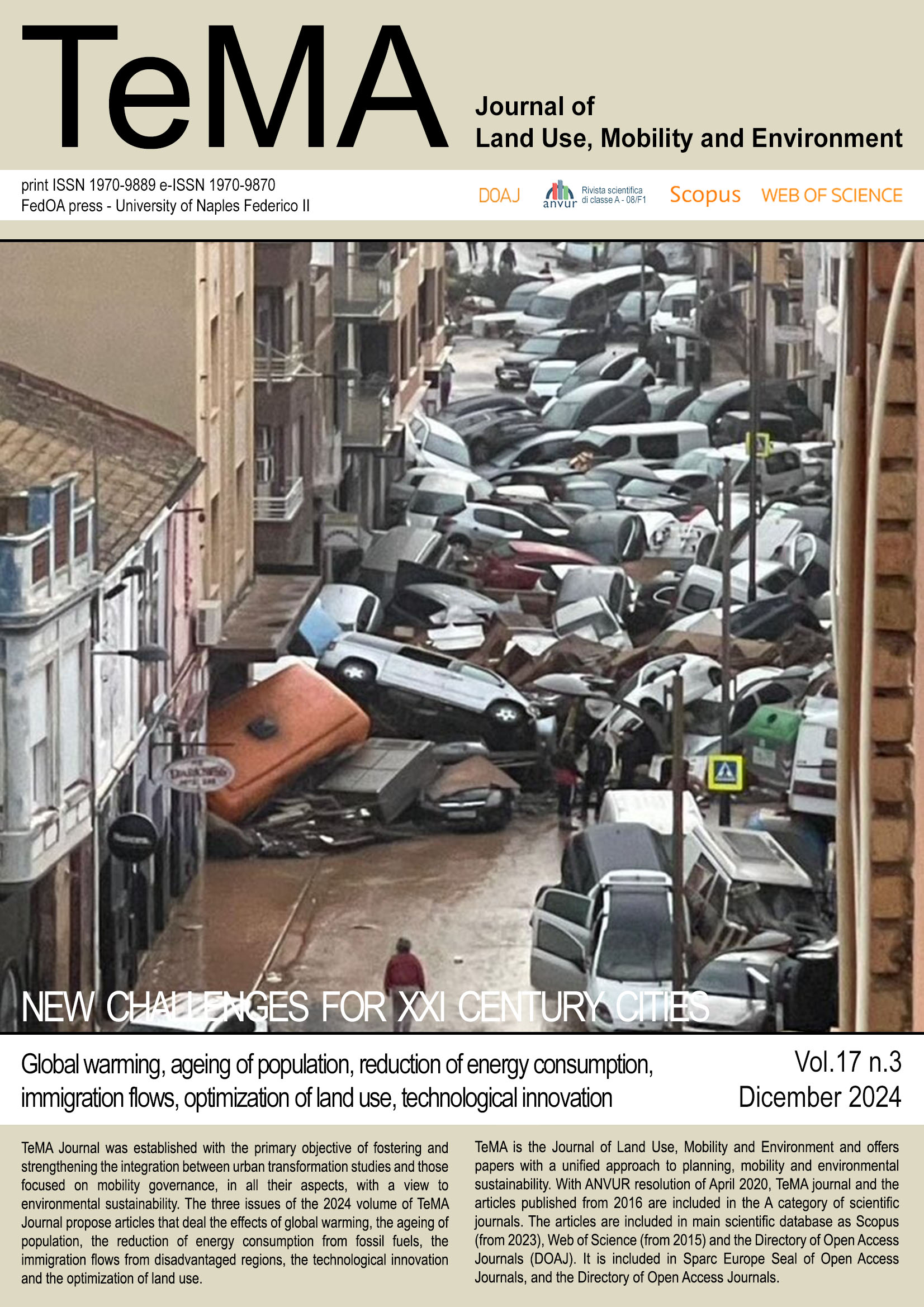Governance of the energy transition: the role of local authorities in Italy
DOI:
https://doi.org/10.6093/1970-9870/11168Keywords:
Energy transition, Renewable energy comunities, Local regulations, Urban planningAbstract
Starting from the relationship between urban planning and mobility management, TeMA has gradually expanded the view of the covered topics, always remaining in the groove of rigorous scientific in-depth analysis. This section of the Journal, Review Notes, is the expression of continuously updating emerging topics concerning relationships between urban planning, mobility and environment, through a collection of short scientific papers written by young researchers. The Review Notes are made of four parts. Each section examines a specific aspect of the broader information storage within the main interests of TeMA Journal. This section, International Regulations and Legislation for the Energy Transition, explores the challenges and opportunities in the urban context to understand the evolving landscape of the global energy transition. The contribution explores how Italian local authorities contribute to the energy transition, in line with European directives. It highlights the importance of territorial governance plans and urban transformation tools in promoting the use of renewable energies and reducing emissions. Renewable Energy Communities (RECs) are identified as key instruments, thanks to the direct involvement of citizens and local energy autonomy. Finally, the contribution also highlights the challenges related to regulatory fragmentation and the need for greater coordination.
Downloads
References
Barbaro, S. & Napoli, G. (2023). Energy communities in urban areas: Comparison of energy strategy and economic feasibility in Italy and Spain. Land, 12 (7), 1282. https://doi.org/10.3390/land12071282
Bashi, M. H., De Tommasi, L., Cam, A. L., Relaño, L. S., Lyons, P., Mundó, J., Pandelieva-Dimova, I., Schapp, H., Loth-Babut, K., Egger, C., Camps, M., Cassidy, B., Angelov, G. & Stancioff, C. E. (2022). A review and mapping exercise of energy community regulatory challenges in European member states based on a survey of collective energy actors. Renewable and Sustainable Energy Reviews, 172, 113055. https://doi.org/10.1016/j.rser.2022.113055
Bevilacqua, C. & Milazzo, S. (2022). Le comunità energetiche e la sussidiarietà orizzontale tra governance dell’energia e sviluppo locale. In G. Armao, F. Astone, M. Immordino, G. Moscella & V. Prudente (a cura di), Specialità e differenziazione. Le nuove frontiere del regionalismo italiano, 449-463. Napoli: Editoriale Scientifica.
Cecchini, A. (2023). Il divenire della disciplina urbanistica: il contributo di Arnaldo Cecchini. TeMA - Journal of Land Use, Mobility and Environment, (1), 37-59. https://doi.org/10.6093/1970-9870/9744
Cutini, V. (2023). Il divenire della disciplina urbanistica: il contributo di Valerio Cutini. TeMA - Journal of Land Use, Mobility and Environment, (1), 85-96. https://doi.org/10.6093/1970-9870/9746
Derkenbaeva, E., Vega, S. H., Hofstede, G. J. & Van Leeuwen, E. (2022). Positive energy districts: Mainstreaming energy transition in urban areas. Renewable and Sustainable Energy Reviews, 153, 111782. https://doi.org/10.1016 /j.rser.2021.111782
Di Gesù, V. (2021). Il riparto di competenze tra Stato e Regioni in materia di energia dal primo regionalismo alla clausola di asimmetria. Italian papers on federalism. https://www.ipof.it/wp-content/uploads/2021/03/Di_Gesu%CC%80_Energia.pdf
Gjorgievski, V. Z., Velkovski, B., Minuto, F. D., Cundeva, S. & Markovska, N. (2023). Energy sharing in European renewable energy communities: Impact of regulated charges. Energy, 281, 128333. https://doi.org/10.1016/j.energy.2023.128333
Gargiulo, C. & Papa, R. (2021). Chaos and chaos: the city as a complex phenomenon. TeMA - Journal of Land Use, Mobility and Environment, 14 (2), 261-270. https://doi.org/10.6093/1970-9870/8273
Krug, M., Di Nucci, M. R., Caldera, M. & De Luca, E. (2022). Mainstreaming community energy: Is the renewable energy directive a driver for renewable energy communities in Germany and Italy? Sustainability, 14 (12), 7181. https://doi.org/10.3390/su14127181
Lai, S., Isola, F., Leone, F. & Zoppi, C. (2021). Assessing the potential of green infrastructure to mitigate hydro-geological hazard. TeMA - Journal of Land Use, Mobility and Environment, 109-133. https://doi.org/10.6093/1970-9870/7411
Legambiente. (2022). Scacco matto alle rinnovabili 2022. https://www.legambiente.it
Legambiente. (2023). Comuni Rinnovabili. Available at: https://www.legambiente.it/wp-content/uploads/2023/06/Comuni-Rinnovabili-2023.pdf
Mazzeo, G. & Polverino, S. (2023). Nature-based solution for climate change adaptation and mitigation in urban areas with high natural risk. TeMA - Journal of Land Use, Mobility and Environment, 16 (1), 47-65. https://doi.org/10.6093/1970-9870/9736
Martinelli, V. (2024). New trends in energy transition policies: citizens’ involvement in the European energy market. TeMA - Journal of Land Use, Mobility and Environment, 17(1), 147-153. https://doi.org/10.6093/1970-9870/10772
Musolino, M., Maggio, G., D’Aleo, E. & Nicita, A. (2023). Three case studies to explore relevant features of emerging renewable energy communities in Italy. Renewable Energy, 210, 540-555. https://doi.org/10.1016/j.renene.2023.04.094
Neves, C., Oliveira, T. & Santini, F. (2024). Citizen participation in local energy communities: a meta and weight analysis. Sustainability Science Practice and Policy, 20 (1). https://doi.org/10.1080/15487733.2024.2366628
Papa, R., Gargiulo, C., & Battarra, R. (2016). Città Metropolitane e Smart Governance: Iniziative di successo e nodi critici verso la Smart City (Vol. 1). FedOA-Federico II University Press. https://doi.org/10.6093/978-88-6887-005-8
REScoop.eu. (2020). Comunità energetiche: Comuni ed enti locali, un partner ideale. https://www.rescoop.eu/uploads/rescoop/downloads/Community-Energy-Guide-Factsheet-IT.pdf
Sarrica, Mauro, Fulvio Biddau, Sonia Brondi, Paolo F. Cottone, and Bruno M. Mazzara. (2018). A multi-scale examination of public discourse on energy sustainability in Italy: empirical evidence and policy implications. Energy Policy 114, 444-454. https://doi.org/10.1016/j.enpol.2017.12.021.
Savino, M. (2023). Il divenire della disciplina urbanistica: il contributo di Michelangelo Savino. TeMA - Journal of Land Use, Mobility and Environment, 135-143. https://doi.org/10.6093/1970-9870/9752
Trevisan, R., Ghiani, E. & Pilo, F. (2023). Renewable Energy Communities in Positive Energy Districts: A Governance and Realisation Framework in Compliance with the Italian Regulation. Smart Cities, 6 (1), 563–585. https://doi.org/10.3390/smartcities6010026
Downloads
Published
How to Cite
Issue
Section
License
Copyright (c) 2024 Valerio Martinelli

This work is licensed under a Creative Commons Attribution-NonCommercial 4.0 International License.



